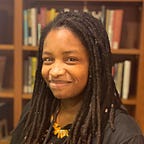The Climate Kids
Helping the Youth Climate Coalition maintain momentum after the global strike on September 20th.
By Diara J. Townes and Lakshmi Sivadas
Since November 2018, Lakshmi and I covered climate and environmental actions by various activist organizations, such as WEACT, New York Communities for Change, 350.org, and the youth climate strikes. We built relationships, interviewed leaders, and published assignments in different mediums on their collective and individual actions to get the city and state to pass legislation in favor of environmental protections.
As a marine and environmental scientist, I’ve been dedicated to research, education and action when it comes to protecting the environment. I’ve worked at various aquariums and science institutions along the eastern seaboard, developing an understanding and appreciation for science education and communication.
While we were observing and reporting on the #Fridays4Future youth climate movement, we met with a half-dozen junior and high school student organizers. They’ve led thousands of their peers across New York City in Friday climate strikes from school.
The first global strike took place on March 15th, the second on May 24th. Core organizers like Alexandria Villaseñor and Olivia Wohlgemuth both voiced concern about the constraints they were working with — students who cannot strike often from school, police permits for large gatherings and organizing students en masse.
They planned a #climatestrikesummer, a series of smaller protests aimed at particular sectors of economy, government and media against their inaction and/or contribution to the climate crisis.
The third big strike will occur on September 20th, the Friday before the United Nations Climate Summit. The strike leaders have yet to select what or when their next action will be after that big strike concludes.
We spoke with the youth media leaders Spencer Berg and Shiv Soin at the United Nations school strike on Friday September 6, which welcomed Swedish teen and global climate activist Greta Thunberg, about their next steps following the September 20th strike.
The main concern they have now, according to the conversations we’ve had with them and other members of the coalition’s Core Committee, is how do they maintain the interest and collective action they built over the last five weeks?
They have ideas about holding community “green” events, sending out newsletters and calling for rallies. There’s nothing conclusive yet, as all their efforts, outside of being middle and high school students with homework, tests and even college applications, are on building up the global strike on September 20th in Foley Square.
While we are still in our ideating phase, working to develop a prototype in our Startup Sprint class with Jeremy Caplan, we’ve come up with three different ways to serve the youth climate strikers:
- Fashion a messaging tool such as a chatbot that allows the organizers to maintain the strength of their coalition and the attention of their peers that don’t have leadership roles in the movement. In between their large, crowd-sourced global events, where social and mainstream media coverage brought in numbers, attendance at their smaller strikes over the summer dropped off. They don’t want a repeat of that after September 20th.
- Create a direct messaging tool or newsletter for press and media that shares what the Youth Climate Coalition is doing on a consistent basis. This could be the minutes after a planning committee meeting, an announcement on the events they’re holding and so forth. The goal is to keep media in the loop over a long period of time so they are familiar with the coalition rather than reactive, as the movement expects to continue growing. Kids telling kids what they’re up to in the movement is important, but the messaging exists in an echo chamber. A growing movement of kids telling CEOs and politicians via the press and media could be a more effective way to create change.
- Connect adult and youth climate organizers via an event or forum that allows kids and adults to exchange ideas, discuss best practices and plan events together, moving forward. Over the last year, we’ve connected with a multitude of expert, academic and official voices in the climate and coastal resiliency areas of New York City. We’ve met with dozens of climate and environmental justice advocates and activists who could provide an excellent panel for youth leaders to hear from. If interested, we could develop a workshop that allows students and adults to use design-thinking practices to understand the needs of the climate activist community as well as those most impacted.
The specifics of our solution will depend on the feedback we receive from the youth climate coalition, as well as the other nonprofit and advocacy organizations we’ve worked with over the last year.
We hope to leverage the email list of the communications committee to push forward a survey to all the climate strikers registered in New York City, and beyond. This way, we can collect a large dataset of responses from the community we serve, in addition to the dozen or so student leaders.
We will be receptive to their feedback and adjust our solution as necessary to meet their ideas of what’s next, what’s needed and what we can do to help.
